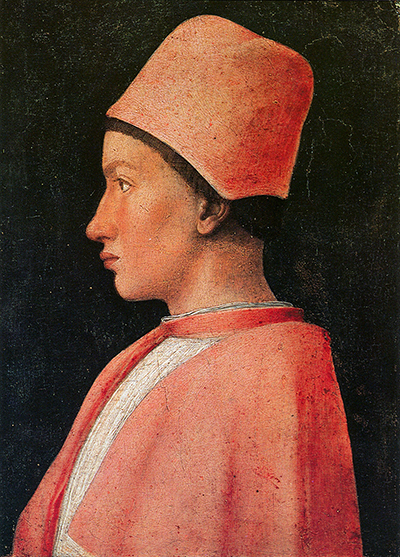Portrait of Francesco Gonzaga, created in the year 1461 by Andrea Mantegna, is a tempera-on-panel painting of a noble youth who was made a Cardinal at the age of seventeen.
The profile portrait, displayed in the National Museum of Capodimonte in Naples, depicts the teenager in the attire of a senior ecclesiastical leader of the Roman Catholic Church. Gonzaga, the second son of the Marquis and Marquise of Mantua, had secured his elevated position within the Church hierarchy via his family connections and the portrait was painted at his father’s palace. This painting was created at a time when the use of tempera paint, formed by combining pigments with egg yolk, was being superseded by the use of the oil paints that would come to characterise Renaissance artworks.
Mantegna, born in the Venetian Republic, had been appointed to the role of court artist by Ludovico III Gonzaga in 1460 and the portrait of the Mantuan leader’s second son was one of the first paintings that the Italian artist completed during his time at the palace. The profile portrait, in which the subject is facing towards the left-hand side of the panel, represents a new high in the fortunes of the Gonzaga family. Albrecht III Achilles, the Elector of Brandenburg, had persuaded Pope Pius II to elevate Francesco Gonzaga to the rank of Cardinal after the Pope had attended the Council of Mantua in 1459. Albrecht III was the brother of John, Margrave of Brandenburg-Kulmbach, who was Gonzaga's maternal grandfather and this family connection was instrumental in the young cleric's promotion to Cardinal.
The head-and-shoulders portrait, in which the figure of Gonzaga is superimposed upon a black background, shows the youth wearing a zucchetto on his head and a mozzetta over his shoulders. These garments, coloured red to symbolise a Cardinal's duty to shed his blood in the defence of the faith, demonstrate that Gonzaga has acquired the power and status of a high-ranking member of the clergy. The whiteness of Gonzaga's rochet, worn under his red mozzetta, symbolises purity. The light in the painting, falling on Gonzaga's face and chest while leaving his back edged by a line of shadow, is emanating from a position to the left of the subject. This profile portrait, a popular genre during Renaissance times, captures Gonzaga's image for posterity.




